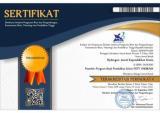Ethnochemistry: Exploring the Potential of Samawa Local Wisdom as a Source for Learning Chemistry
Abstract
One problem in chemistry learning at the secondary and tertiary levels is the availability of appropriate learning resources. To address this problem, it needs contextual teaching materials to implement an ethnochemistry learning approach. This research aims to explore and develop the traditional potential of Samawa local wisdom as chemistry learning material. In addition, this study also explored resources that can be used in teaching chemistry. This qualitative research utilized literature studies, interviews, and documentation to collect the data and was analyzed using Miles & Huberman’s qualitative analysis. As for the sample used in this study were 10th grade students of SMAN 2 Taliwang. I use 2 classes, 1 class as the control class and 1 class as the experimental class.The community leaders, chemistry content experts, and relevant chemistry literature were selected as the study subject. Based on the findings, it can be concluded that Samawa’s local wisdom can be used as a source of chemistry learning through integration with Samawa culture on chemical bonding material. Therefore, this research is expected to be a reference in developing contextual chemistry teaching to create more significant and exciting learning since it is relevant to real-life experience.
Keywords
Full Text:
PDFReferences
Abramova, I., & Greer, A. (2013). Ethnochemistry and human rights. Chemistry and Biodiversity, 10(9), 1724–1728. https://doi.org/10.1002/cbdv.201300211
Ador, N. K. S. (2017). Ethnochemistry of Maguindanaons’ on the Usage of Household Chemicals: Implications to Chemistry Education. Journal of Social Sciences (COES&RJ-JSS), 6(2S), 8–26. https://doi.org/10.25255/jss.2017.6.2s.8.26
Aldian, H., & Wahyudiati, D. (2023). Analisis Pengaruh Bahan Ajar Kimia Berbasis IT Terhadap Keterampilan Kolaborasi dan Komunikasi Siswa. Jurnal Paedagogy, 10(1), 207-216.
Çalik, M., Ültay, N., Kolomuç, A., & Aytar, A. (2015). A cross-age study of science student teachers’ chemistry attitudes. Chemistry Education Research and Practice, 16(2), 228–236. https://doi.org/10.1039/c4rp00133h
Col, R. K., Dalgety, J., & Salter, D. (2016). The Development of the Chemistry Attitudes and Experiences Questionnaire (Caeq). Chem. Educ. Res. Pract., 3(1), 19–32. https://doi.org/10.1039/b1rp90038b
De Jong, O. (2018). Making chemistry meaningful. Conditions for successful context-based teaching. Educación Química, 17(4e), 215. https://doi.org/10.22201/fq.18708404e.2006.4e.66010
Fadli, A. (2018). Chemical Bonding and Local Islamic Wisdom of Sasak Tribe, Lombok, West Nusa Tenggara. IBDA` : Jurnal Kajian Islam Dan Budaya, 16(1), 53–67. https://doi.org/10.24090/ibda.v16i1.1389
Fadli, A. (2019). Analisis Sikap Ilmiah Calon Guru PAI dalam Perspektif Gender. 8(2), 51–58.
Fadli, A., & Irwanto. (2020). The effect of local wisdom-based ELSII learning model on the problem-solving and communication skills of pre-service islamic teachers. International Journal of Instruction, 13(1), 731–746. https://doi.org/10.29333/iji.2020.13147a
Hasanah, J., Wahyudiati, D., & Ningrat, H. K. (2016). Pengembangan Kartu Bergambar Sains Sebagai Media Pembelajaran Biologi Pokok Bahasan Sistem dalam Kehidupan Tumbuhan Kelas VIII MTS Darul Aman Selagalas Tahun Pelajaran 2015/2016. Biota, 9(2), 241–255.
Huitt, W., & Dawson, C. (2017). Social development: Why it is important and how to impact it. Educational Psychology Interactive, 20(1), 80–100.
Marasinghe, B. (2016). Ethnochemistry and Ethnomedicine of Ancient Papua New Guineans and Their Use in Motivating Students in Secondary Schools and Universities in PNG. Universal Journal of Educational Research, 4(7), 1718–1720. https://doi.org/10.13189/ujer.2016.040726
Rahmawati, Y., Ridwan, A., & Nurbaity. (2017). Should we learn culture in chemistry classroom? Integration ethnochemistry in culturally responsive teaching. AIP Conference Proceedings, 1868. https://doi.org/10.1063/1.4995108
Rosa, M., & Clark, D. (2017). Ethnomathematics: the cultural aspects of mathematics. Revista Latinoamericana de Etnomatemática: Perspectivas Socioculturales de La Educación Matemática, 4(2), 32–54.
Suanda, N., & Wahyudiati, D. (2023). Ethnochemistry: Analysis of the Relevance of Material Atomic Structure with the Ngejot Tradition as a Source for Learning Chemistry. Hydrogen: Jurnal Kependidikan Kimia, 11(3).
Sumardi, L., Rohman, A., & Wahyudiati, D. (2020). Does the teaching and learning process in primary schools correspond to the characteristics of the 21st century learning? International Journal of Instruction, 13(3), 357–370. https://doi.org/10.29333/iji.2020.13325a
Sumardi, L., & Wahyudiati, D. (2021). Using Local Wisdom to Foster Community Resilience During the Covid-19 Pandemic: A Study in the Sasak Community, Indonesia. Proceedings of the 2nd Annual Conference on Education and Social Science (ACCESS 2020), 556(Access 2020), 122–127. https://doi.org/10.2991/assehr.k.210525.059
Sutrisno, H., Wahyudiati, D., & Louise, I. S. Y. (2020). Ethnochemistry in the Chemistry Curriculum in Higher Education: Exploring Chemistry Learning Resources in Sasak Local Wisdom. Universal Journal of Educational Research, 8(12A), 7833–7842. https://doi.org/10.13189/ujer.2020.082572
Wahyudiati, D. (2016). Analisis Efektivitas Kegiatan Praktikum Sebagai Upaya Peningkatan Hasil Belajar Mahasiswa. Jurnal Tatsqif, 14(2), 143–168. https://doi.org/10.20414/jtq.v14i2.27
Wahyudiati, D., Rohaeti, E., Irwanto, Wiyarsi, A., & Sumardi, L. (2020). Attitudes toward chemistry, self-efficacy, and learning experiences of pre-service chemistry teachers: Grade level and gender differences. International Journal of Instruction, 13(1), 235–254. https://doi.org/10.29333/iji.2020.13116a
Wahyudiati, D., Sutrisno, H., & Louise, I. S. Y. (2019). Investigation Of Attitudes Toward Chemistry And Learning Experiences of Pre-Service Chemistry Teachers. MIER Journal of Educational Studies, Trends and Practices, 9(2).
Wahyudiati, D. (2020). Pengembangan model pembelajaran berbasis masalah terintegrasi kearifan lokal Sasak (PBMTKLS) pada pembelajaran kimia untuk keterampilan proses sains, sikap ilmiah, dan prestasi kognitif mahasiswa. (Disertasi). Program Pascasarjana Universitas Negeri Yogyakarta, Yogyakarta.
Wahyudiati, D & Fitriani. (2021). Etnokimia: eksplorasi potensi kearifan lokal Sasak sebagai sumber belajar kimia. Jurnal Pendidikan Kimia Indonesia, 5(2), https://doi.org/10,23887/jpk.v512.38 537
Wahyudiati, D., & Qurniati, D. (2023). Ethnochemistry: Exploring the Potential of Sasak and Javanese Local Wisdom as a Source of Chemistry Learning to Improve the Learning Outcomes of Pre-Service Teachers. Jurnal Pendidikan Sains Indonesia (Indonesian Journal of Science Education), 11(1), 12-24.
Wahyudiati, D. (2023). The Relationship between Ethnochemistry Learning Experience and Cognitive Learning Outcomes Based on Gender. Jurnal Pendidikan: Teori, Penelitian, dan Pengembangan, 8(1), 57-61.
Wiwit; Ginting, S. M., & Firdaus, M. L. (2014). Penerapan Pembelajaran Kimia Dasar Menggunakan Media Powerpoint 2010 Dan Phet Simulation Dengan Pendekatan Modification Of Reciprocal Teaching Berbasis Konstruktivisme. Exacta, 11(1), 29–32.
DOI: https://doi.org/10.33394/hjkk.v11i4.8402
Refbacks
- There are currently no refbacks.

This work is licensed under a Creative Commons Attribution-ShareAlike 4.0 International License.





